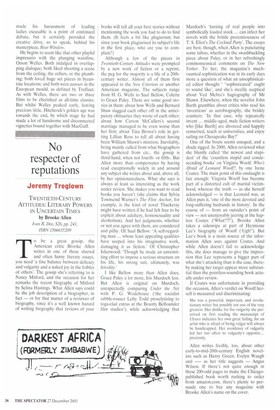A lighter shade of genius
Benjamin Davis
ALFRED HITCHCOCK: A LIFE IN DARKNESS AND LIGHT by Patrick McGilligan Wiley, £19.99, pp, 850, ISBN 0470869720
Anyone who has ever had a duff interview will feel for James Kennaway, the screenwriter who met with Hitchcock in 1962 to discuss the possibility of his scripting the director's next venture about a flock of birds attacking a Bodega Bay community. 'I see this film done only one way,' declared the cocksure scribe: 'You should never see a bird'.
Poor Kennaway, with his subtle Greek notions of drama in absentia. He should have realised that Hitchcock held affinities with the science fiction directors of the late Fifties, who made films with titles like The Blob, which, lo and behold, featured a giant jelly on the rampage. The Birds would do exactly what it said on the tin: whether stuck to climbing frames or Tippi Hedren's face, our winged cousins are the ubiquitous subject, serving as vehicles for the apocalyptic theme of nature's rebellion against mankind. Hitchcock's mantra was to 'put the audience through it'. Just as he masshypnotised his public in Vertigo with a swirling helix around Jimmy Stewart's head, he created ornithophobia (not to mention pteronophobia — the fear of being tickled by feathers) by turning the screen into a flapping, pecking, squawking aviary. Hitchcock was one of cinema's most exacting visual storytellers. Having left his Catholic school to go into advertising, he became a consummate storyboarder before falling under the spell of the 1920s German expressionists, Patrick McGilligan argues persuasively that the major sequences in his films (Psycho's shower, North by Northwest's crop duster), could be viewed as perfect short silent films; the images arrived in his pachydermous pate ready-formed, but utterly distinct from any narrative. For example, he was once haunted by the image of Cary Grant up Abraham Lincoln's nostril on Mount Rushmore. What the hero was doing there, or how he got there, the director didn't have the slightest notion, but 'The Man in Lincoln's Nose' provided the visual genesis for the film which a decade later would become North by Northwest. All he needed to do was link the nostril with the crop duster. For Hitchcock the script was 'the second stage'. It comes as no surprise, then, to find that he rubbed the literati up the wrong way. Best hissy fit goes to Raymond Chandler, who made a spectacularly bitter exit from Strangers on a Train, claiming he preferred to work with someone who thought the dialogue more important 'than shooting it upside down through a glass of champagne'. Writing in The Spectator about the 1930s run-for-cover capers, Graham Greene opined that Hitchcock had an 'inferior sense of reality'; whilst Leon Uriz, who worked with Hitchcock on Topaz, felt that the director saw the 'writer as enemy'. The dearth of characterisation or motivation also made life difficult for his actors, whom he famously referred to as 'cattle'. One wonders what Stanislavski would have made of Hitchcock's advice to Gregory Peck when he was struggling to find his character's inner life. 'My dear boy,' Hitchcock croaked, 'I couldn't care less what you were thinking. Just let your face drain of all expression.' • So the problem with most of Hitchcock's films is that the meticulously sketched shots are adhered to, while the story is left inchoate, with illogical leaps and gaping inconsistencies. Hitchcock despised those who questioned his logic, whom he dubbed 'the implausibles'. Film should be stronger than reason, and the willing suspension of disbelief was powerful enough that when a bomb or murderer was in the room, 'Descartes can go boil his head'. He revelled in the employment of `MacGuffins', which were designed to advance the plot whilst providing 'the quality of imperfection'. They became an infuriating habit, however, which made watertight plots leak profusely, merely serving to stamp the former advertiser's brand name on his product.
Previous biographies, such as Donald Spoto's The Dark Side of Genius, have portrayed a dark, twisted and leching voyeur. Patrick McGilligan's intention in this illuminating, if pedestrian, chronology is to redress the balance and show how the mythical persona was ineluctably linked with the marketed image of Hitchcock. The icon of the portly silhouette became a global brand, a MacGuffin in its own right. McGilligan's real McCoy was actually a big joker, who would host formal dinners where all the food and drink was tinged with blue dye, and who, on the occasion of his 55th birthday, made his secretary announce to cast and crew. 'Ladies and gentlemen, would you all come into the other room, please, and have a piece of Mr Hitchcake's cock?' It was all in the best possible taste, of course, as the old boy had long been impotent. Whether this made his harassment of leading ladies excusable is a point of continued debate, but it certainly provided the creative drive, so to speak, behind his masterpiece, Rear Window.
He begins to seem like that other playful impresario with the plunging waistline, Orson Welles. Both indulged in overlapping dialogue; both liked shooting a scene from the ceiling, the cellars, or the plumbing; both loved huge set pieces in byzantine locations; and both were auteurs in the European mould, as defined by Truffaut, As with Welles, there are two or three films to be cherished as all-time classics. But whilst Welles peaked early, leaving precious little, Hitchcock's golden age was towards the end, by which stage he had made a lot of handsome and disconnected vignettes bound together with MacGuff.



























































 Previous page
Previous page